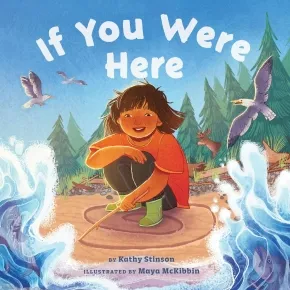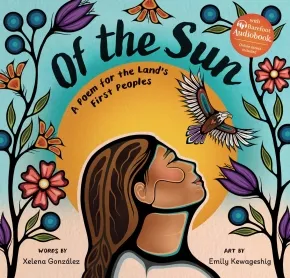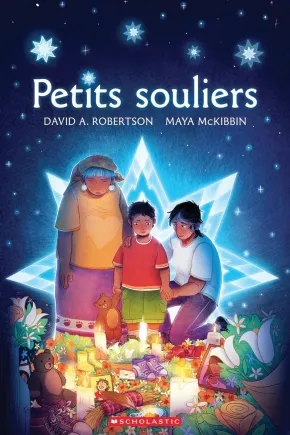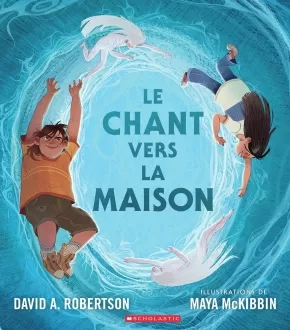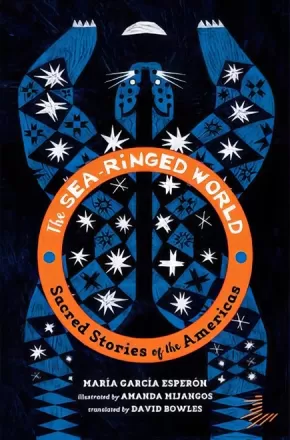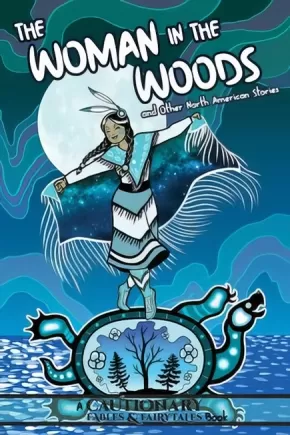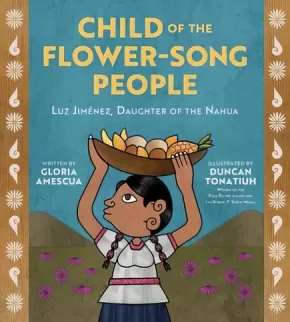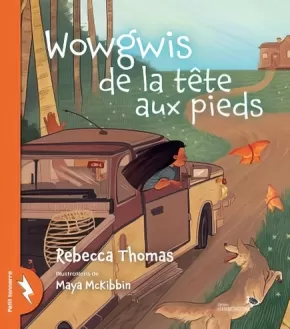
Indigenous Peoples in Mexico
1
-
11
of
11 Results;
Sort By
If You Were Here
$23.95
Format:
Hardcover
ISBN / Barcode: 9781771649926
Synopsis:
Synopsis:
For kids ages 3-7, this lyrical picture book explores the complex emotions around missing a loved one, with stunning illustrations by Ojibwe artist Maya McKibbin.
I wish I could show you…
this great big meadow,
like a sea of lacy clouds….
In this beautiful ode to nature and mindfulness, a child sets out to explore the environment around their home, using all their senses. Yet, someone important is missing, someone the child wishes could be there on the journey.
Expressive text by Kathy Stinson leaves room for readers’ own interpretations about who the child in the story might be missing, while Indigenous illustrator Maya McKibbin’s gorgeous images capture the lush beauty of the natural world and the tenderness of a child’s emotions.
The perfect book for helping a child navigate loss, or missing someone that can’t be there with them.
Reviews
“Radiant images and a spacious narrative provide adults with an uplifting space to discuss heavy emotions with young ones ... A glowing window into grieving that makes room for sorrow and joy to coexist.”—Kirkus Reviews
"Lovely descriptive language….will lead to discussions about loss and how spending time in nature can be healing. A gentle book dealing with grief, told through the lens of the natural world.”—School Library Journal
Educator Information
Recommended for ages 3 to 7.
Additional Information
40 pages | 9.00" x 9.00" | Hardcover
Little Shoes
$24.99
Format:
Hardcover
Text Content Territories:
Indigenous Canadian; First Nations; Cree (Nehiyawak);
ISBN / Barcode: 9781774881729
Synopsis:
Synopsis:
From the bestselling and Governor General's Award–winning author of On the Trapline comes a beautifully told and comforting picture book about a boy's journey to overcome generational trauma of residential schools.
Deep in the night, when James should be sleeping, he tosses and turns. He thinks about big questions, like why we don't feel dizzy when the Earth spins. He looks at the stars outside his bedroom and thinks about the night sky stories his kōkom has told him. He imagines being a moshom himself. On nights like these, he follows the moonlit path to his mother's bedroom. They talk and they cuddle, and they fall asleep just like that.
One day, James's kōkom takes him on a special walk with a big group of people. It's called a march, and it ends in front of a big pile of things: teddy bears, flowers, tobacco ties and little shoes. Kōkom tells him that this is a memorial in honor of Indigenous children who had gone to residential schools and boarding schools but didn't come home. He learns that his kōkom was sent away to one of these schools with her sister, who also didn't come home.
That night, James can't sleep so he follows the moonlit path to his mother. She explains to James that at residential school when Kōkom felt alone, she had her sister to cuddle, just like they do. And James falls asleep gathered in his mother's arms.
Includes an author note discussing the inspiration for the book.
Reviews
"Robertson (Norway House Cree Nation) sensitively approaches this history, never explicitly describing the horrors of residential schools but instead leaving space for adults to grapple with youngsters’ questions in their own ways. Though he doesn’t provide easy answers, it’s clear that familial love keeps this child buoyed. Suffused with pinks, icy blues, and deep indigos, the glowing, cartoon-style digital illustrations from McKibbin (Ojibwe) depict the ancestral bonds that keep James rooted. Honest yet age-appropriate and deeply uplifting." —Kirkus Reviews
"Cree author Robertson reteams with Ojibwe, Yoeme, and Irish artist McKibbin (The Song That Called Them Home) for this work that honors children who did not return from residential schools. . . . James and his mother’s musing on intergenerational story-sharing further contribute to themes of connection and loss in this emotional work." —Publishers Weekly
"[Robertson and McKibbin] have taken on the weighty task of presenting a catastrophic loss to young readers, but also offering hope and determination. With poetic text and images of family life that are both familiar and mystical in tone, they have achieved this goal. . . . The honesty of Little Shoes is an antidote to fear." —Imaginary Elevators
"[A] big story about generational trauma of residential schools [which] focuses on the comfort that comes from family. Maya McKibbin evokes comfort and discomfort, as well as affection and thoughtfulness, with great sensitivity. . . . [A] great discussion starter for families and classes about residential schools, about Every Child Matters, and about asking questions. But it will also inspire understanding and empathy for that which has happened so that tragedies like residential schools are not repeated." —CanLit for Little Canadians
Educator Information
Recommended for ages 3 to 7.
This book is available in French: Petits souliers
Additional Information
48 pages | 8.00" x 12.00" | Hardcover
Of the Sun: A Poem for the Land's First Peoples
$22.99
Format:
Hardcover
Text Content Territories:
Indigenous American; Indigenous Canadian; Indigenous Caribbean; Indigenous Peoples in Mexico; Indigenous South American;
Grade Levels: Preschool; Kindergarten;
ISBN / Barcode: 9798888596500
Synopsis:
Synopsis:
A powerful and hopeful ode to Indigenous children.
Indigenous. Native. On this land, you may roam.
Child of the sun, on this land, you are home.
Of the Sun is an uplifting and mighty poem that wraps the Indigenous children of the Americas in reassuring words filled with hope for a brighter future and reminders of their bond and importance to the land. Each page fills them with pride and awe of their cultural heritage and invites them to unite and inspire change in the world.
Paired with powerful art reflecting cultures of various Indigenous Nations and Tribes, the poem offers all readers a sense of the history and majesty of the land we live on and how we can better care for ourselves and the world when we recognize our connection to the land and to each other.
Written by Xelena González, poet and activist in the Native and Latinx communities, and an enrolled member of the Tap Pilam Coahuiltecan Nation. Bold illustrations by prominent Anishinaabe illustrator Emily Kewageshig depict landscapes across the Americas and children from many backgrounds
Endnotes provide more information on Native and Indigenous unity and activism in younger generations
Reviews
"Of The Sun is a loving homage to the Indigenous peoples of this land—both in González’s beautiful, lyrical poem and Kewageshig’s warm, vibrant Anishinaabe-styled artwork. A wonderful read aloud you must add to bookshelves at home, at school, and in community!" - Traci Sorell, award-winning author of We Are Grateful Otsaliheliga and At The Mountain’s Base
"A luminous song, poem, promise
of cultures and connection,
of kinship and caring,
for Indigenous children across the continent." - Cynthia Leitich Smith, author of Jingle Dancer
Educator Information
Recommended for ages 3 to 5.
Subjects / Themes / Topics Included: Indigenous Peoples in the Americas; Poetry; Land Connection; Inuit Clothing; Traditional Hair Bun (tsiiyéél); Concheros Dance; Three Sisters; La Danza de la Flor de Piña; Smoke Dance; Jingle Dress Dance; Manoomin (Wild Rice); English Words from Indigenous Languages; Indigenous Farming Practices; Bison; Land Back Movement.
Additional Information
32 pages | 10.00" x 9.75" | Hardcover
Petits souliers
$15.99
Format:
Paperback
Text Content Territories:
Indigenous Canadian; First Nations; Cree (Nehiyawak);
ISBN / Barcode: 9781039713048
Synopsis:
Synopsis:
L’auteur du livre à succès Ligne de trappe, lauréat du Prix du Gouverneur général, nous offre un magnifique album illustré sur le cheminement d’un garçon qui tente de surmonter le traumatisme générationnel causé par les pensionnats indiens.
Au coeur de la nuit, alors qu’il devrait dormir, James tourne et se retourne dans son lit. Il se pose de grandes questions, comme pourquoi n’avons nous pas le vertige alors que la Terre tourne. Durant des nuits comme celle-ci, il suit le chemin éclairé par le clair de lune jusqu’à la chambre de sa mère. Ils parlent, puis sa mère le prend dans ses bras et ils s’endorment comme ça.
Un jour, la kōkom de James l’emmène faire une promenade spéciale avec un grand groupe de personnes. Cela s’appelle une marche, et celle-ci se termine devant un grand tas d’objets : des ours en peluche, des fleurs, du tabac tressé et des petits souliers. Kōkom explique à James qu’il s’agit d’un monument commémoratif en l’honneur des enfants autochtones qui sont allés dans des pensionnats, mais qui n’en sont jamais revenus. Il apprend que sa kōkom a été emmenée dans l’une de ces écoles avec sa soeur, qui n’est pas non plus rentrée chez elle.
Cette nuit-là, James n’arrive pas à dormir et suit encore une fois le chemin éclairé par le clair de lune jusqu’à la chambre de sa mère.
Comprend une note de l’auteur, qui explique sa source d’inspiration pour ce livre.
Educator Information
Recommended for ages 3 to 7.
This book is available in English: Little Shoes
Additional Information
48 pages | 7.99" x 11.99" | Paperback
Le chant vers la maison
$15.99
Format:
Paperback
Text Content Territories:
Indigenous Canadian; First Nations; Cree (Nehiyawak);
ISBN / Barcode: 9781039701311
Synopsis:
Synopsis:
L’auteur primé de Ligne de trappe nous offre le récit d’une aventure fantastique et cinématique inspirée des légendes autochtones.
Un jour d’été, Lauren et son petit frère, James, partent en voyage sur les terres avec leur moshom (grand-père). Arrivés à destination, les enfants décident d’aller pêcher pour le repas du souper pendant que Moshom fait la sieste. Leur canot se trouve au milieu du lac lorsque l’eau devient soudainement agitée et les fait chavirer! Quand Lauren refait surface, elle voit son frère se faire entraîner par les Memekwesewak, des créatures à l’apparence humaine qui vivent autour de l’eau et aiment jouer des tours aux gens. Lauren doit avoir le courage de suivre les Memekwesewak dans leur monde et de ramener son frère à la maison. Mais ces créatures exercent une forte emprise sur James, et elles ne l’abandonneront pas si facilement.
Un récit écrit avec cœur qui plaira aux lecteurs curieux et aventuriers.
Educator Information
Recommended for ages 4 to 8.
This book is available in English: The Song That Called Them Home
Additional Information
9.25" x 10.22" | Paperback
The Song That Called Them Home
$24.99
Format:
Hardcover
Text Content Territories:
Indigenous Canadian; First Nations; Cree (Nehiyawak);
ISBN / Barcode: 9780735266704
Synopsis:
Synopsis:
From the award-winning author of On the Trapline comes a cinematic fantasy-adventure story inspired by Indigenous legends.
One summer day, Lauren and her little brother, James, go on a trip to the land with their Moshom (grandfather). After they've arrived, the children decide to fish for dinner while Moshom naps. They are in their canoe in the middle of the lake when the water around them begins to swirl and crash. They are thrown overboard and when Lauren surfaces she sees her brother being pulled away by the Memekwesewak — creatures who live in and around water and like to interfere with humans. Lauren must follow the Memekwesewak through a portal and along a watery path to find and bring back James. But when she finally comes upon her brother, she too feels the lure of the Memekwesewak’s song. Something even stronger must pull them back home.
Educator Information
Recommended for ages 4 to 8.
This book is available in French: Le chant vers la maison
Additional Information
52 pages | 9.00" x 10.25" | Hardcover
Swift Fox All Along (PB)
$10.99
Format:
Paperback
Text Content Territories:
Indigenous Canadian; First Nations; Mi'kmaq;
ISBN / Barcode: 9781773214474
Synopsis:
Synopsis:
What does it mean to be Mi’kmaq? And if Swift Fox can’t find the answer, will she ever feel like part of her family?
When Swift Fox’s father picks her up to go visit her aunties, uncles, and cousins, her belly is already full of butterflies. And when he tells her that today is the day that she’ll learn how to be Mi’kmaq, the butterflies grow even bigger. Though her father reassures her that Mi’kmaq is who she is from her eyes to her toes, Swift Fox doesn’t understand what that means. Her family welcomes her with smiles and hugs, but when it’s time to smudge and everyone else knows how, Swift Fox feels even more like she doesn’t belong.
Then she meets her cousin Sully and realizes that she’s not the only one who’s unsure—and she may even be the one to teach him something about what being Mi’kmaq means. Based on the author’s own experience, with striking illustrations by Maya McKibbin, Swift Fox All Along is a poignant story about identity and belonging that is at once personal and universally resonant.
Reviews
“A touching and universal narrative . . . This title should definitely be added to any list of recommended children’s books focused on Indigenous life, family, tradition, feelings, anxiety, fear and self-regulation. Swift Fox All Along is also brimming with cross-curricular applications for school use, including incorporation with science, social studies, history, language, and mental health. Highly Recommended.” — CM Reviews
“Highlights the importance of connections to culture and self.” — Kirkus Reviews, 07/28/20
"This is a straightforward tale of a girl finding her way into a culture that is her heritage, yet new to her. As such, it works effectively. This may suit libraries in need of more modern Native picture books with child appeal.” — School Library Journal, 08/20
Educator Information
Recommended for ages 4 to 7.
Own voices: Illustrator Maya McKibbin is a two-spirited Yaqui, Ojibwe and Irish. Author Rebecca Thomas is an award-winning Mi’kmaw poet. The story is deeply personal. Rebecca is of mixed heritage and grew up off-reserve and was 6 years old before she began getting to know her father. Her dad himself attended a residential school and had lost connection with his culture and language. This was something regained later with wider visits to his home community and wanted to share with his children.
Important themes: the Indigenous story is full of universal themes including family, connection, identity and self-acceptance.
This book is available in French: Wowgwis de la tête aux pieds
Additional Information
36 pages | 9.00" x 10.25" | Paperback
The Sea-Ringed World: Sacred Stories of the America
$25.99
Artists:
Format:
Paperback
Text Content Territories:
Indigenous American; Alaska Native; Alutiiq (Sugpiaq); Native American; Anishinaabeg; Ojibwe (Chippewa); Hopi; Sioux; Indigenous Canadian; Inuit; Indigenous Caribbean; Taino; Indigenous Central American; Indigenous Peoples in Costa Rica; Bribri; Indigenous Peoples in Mexico; Huichol; Nahuas; Maya; Nahuas; Indigenous South American;
ISBN / Barcode: 9781646141517
Synopsis:
Synopsis:
A collection of stories from nations and cultures across our two continents—the Sea-Ringed World, as the Aztecs called it—from the Andes all the way up to Alaska.
Fifteen thousand years before Europeans stepped foot in the Americas, people had already spread from tip to tip and coast to coast. Like all humans, these Native Americans sought to understand their place in the universe, the nature of their relationship with the divine, and the origin of the world into which their ancestors had emerged. The answers lay in their sacred stories.
Educator Information
Recommended for ages 8+
Additional Information
256 pages | 6.31" x 9.11" | Paperback
The Woman in the Woods and Other North American Stories
$22.95
Artists:
Editors:
Format:
Paperback
Text Content Territories:
Indigenous Canadian; First Nations; Anishinaabeg; Odawa (Ottawa); Ojibway; Serpent River First Nation; Cree (Nehiyawak); Plains Cree; Little Pine First Nation; Métis; Indigenous;
ISBN / Barcode: 9781945820977
Synopsis:
Synopsis:
“Be careful of what you accept from spirits.”
Loup Garrou, trickster rabbits, and spirits with names that can’t be spoken — the plains and forests of North America are alive with characters like these, all waiting to meet you in this collection of folklore retold in comics!
Reviews
"Enjoyable for reading aloud or sharing around a campfire." -- KIRKUS
"Explores the stories, passed down through generations, of the people who have inhabited Turtle Island since time immemorial." - Women Write About Comics
Educator Information
Comic book recommended for ages 10 to 12.
The book features more than 100 pages of entertaining and educational stories by artists and writers from Indigenous nations across the continent, including:
- “As It Was Told to Me”, a creation tale that shows that the world needs good and bad to exist, which is written and illustrated by Elijah Forbes, a transgender Odawa illustrator who has facilitated the creation of illustration projects such as the 2020 “Trans Awareness Week.”
- “Chokfi,” the story of the trickster rabbit, who is jealous of Otter's fur coat and tries to steal it, by writer Jordaan Arledge, a trans Chickasaw comic writer and the founder of Arledge Comics, and artist Mekala Nava.
- “White Horse Plains”, a cautionary tale about greed that comes from the Métis settlement St. Francois Xavier, as told by Rhael McGregor, a Non-Binary/Two-Spirit Métis comic artist and animator from Winnipeg, Manitoba.
- “Rougarou” by Mystery Solving Lesbians writer Maija Ambrose Plamondon and Métis-based artist Milo Applejohn, about a werewolf-like creature that haunts the Métis communities.
- “Agonjin In the Water” by the non-binary Ojibawe artist Alice RL, about a girl whose tribe is suffering from a drought and finds a Mishipeshu while searching for water.
- “Woman in the Woods” by the Cuban Taíno artist and storyteller Mercedes Acosta about a curious girl who sees a mysterious figure in the woods at night.
- “Into Darkness” by Izzy Roberts, a Michigan-based illustrator and a member of the Navajo Nation and Kinyaa’áanii clan, about a creature so dangerous and scary that no one dares utter its name.
Additional Information
120 pages | 6.06" x 9.04" | Black and white throughout | Paperback
Child of the Flower-Song People
$23.99
Format:
Hardcover
Text Content Territories:
Indigenous Central American; Indigenous Peoples in Mexico; Nahuas; Aztec; Nahuas;
ISBN / Barcode: 9781419740206
Synopsis:
Synopsis:
Award-winning illustrator Duncan Tonatiuh brings to life debut author Gloria Amescua's lyrical biography of an indigenous Nahua woman from Mexico who taught and preserved her people's culture through modeling for famous artists
She was Luz Jiménez,
child of the flower-song people,
the powerful Aztec,
who called themselves Nahua—
who lost their land but who did not disappear.
As a young Nahua girl in Mexico during the early 1900s, Luz learned how to grind corn in a metate, to twist yarn with her toes, and to weave on a loom. By the fire at night, she listened to stories of her community’s joys, suffering, and survival, and wove them into her heart.
But when the Mexican Revolution came to her village, Luz and her family were forced to flee and start a new life. In Mexico City, Luz became a model for painters, sculptors, and photographers such as Diego Rivera, Jean Charlot, and Tina Modotti. These artists were interested in showing the true face of Mexico and not a European version. Through her work, Luz found a way to preserve her people's culture by sharing her native language, stories, and traditions. Soon, scholars came to learn from her.
This moving, beautifully illustrated biography tells the remarkable story of how model and teacher Luz Jiménez became “the soul of Mexico”—a living link between the indigenous Nahua and the rest of the world. Through her deep pride in her roots and her unshakeable spirit, the world came to recognize the beauty and strength of her people.
The book includes an author’s note, timeline, glossary, and bibliography.
Reviews
“Gloria Amescua narrates the amazing life of Luz Jiménez with lyrical beauty that echoes the very xochicuicatl—ancestral Nahua poetics—that Luz sought to preserve for her people. Child of the Flower-Song People deftly balances fascinating biographical moments with an earnest sense of social justice for the indigenous people of Mexico. Duncan Tonatiuh’s now famous codex-style art, drawn from his own Nahua heritage, makes the story and message even more poignant.” - David Bowles
"An important window into the ravages of colonialism and the plight of the Indigenous peoples of Mexico." - Kirkus Reviews
Educator Information
Recommended for ages 6 to 10
Additional Information
48 pages | 9.00" x 10.00" | Hardcover
Wowgwis de la tête aux pieds
$19.95
Format:
Hardcover
Text Content Territories:
Indigenous Canadian; First Nations; Mi'kmaq;
ISBN / Barcode: 9782923926629
Synopsis:
Synopsis:
Être Mi’gmaq, qu’est-ce que ça signifie?Wowgwis a des papillons dans le ventre. C’est aujourd’hui que son papa l’emmène rencontrer ses tantes, ses oncles et ses cousins. Quand il lui dit, avant de partir, que le jour est venu pour elle d’apprendre ce que c’est qu’être Mi’gmaq, les papillons grossissent.Et s’il fallait que la famille de son papa ne lui ouvre pas les bras?
Educator Information
This book is available in English: Swift Fox All Along
Additional Information
Hardcover
Sort By

